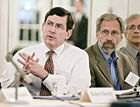
Glenn Barrett, director of energy management for Supervalu
Inc., discusses the importance of energy efficiency in cold storage facilities
and supermarkets.
That was the overriding theme of the sixth Danfoss EnVisioneering Symposium, Breaking Through: Creating an Informed Energy Efficiency Technology Marketplace, held Oct. 23, 2007, at the Hotel Washington in Washington, D.C. About 25 energy stakeholders attended the all-day event, the final one hosted this year by Danfoss, a supplier of components for refrigeration, air conditioning, motion controls, and heating.
The symposium featured six speakers whose organizations have recognized the seriousness and urgency of the global energy situation, and are making strides to improve their education, knowledge, and communication of key energy issues.
Dennis Moran, Eastern region director of energy for Marriott Inc., said one of the challenges facing Marriott is a “limited understanding of the energy issues and technologies among decision-makers and staff,” including building owners. “People tend to avoid the areas they don’t understand,” Moran said. “The situation is improving, but from a very low base.”
Moran believes there is too much emphasis on global warming and not enough emphasis on issues that will drive improvements in the global energy situation. “Responding to carbon hysteria is distracting attention from energy-efficiency improvement,” Moran said. “The true catastrophe will be a shortage of oil and gas.”
Glenn Barrett, director of energy management for Supervalu Inc., which manages 1,300 grocery facilities nationwide, noted that cold storage facilities and supermarkets use about 7 percent of the electricity generated in the United States. As such, Barrett’s mission is to increase the energy efficiency of Supervalu stores and distribution centers.
Barrett said he has learned four key lessons as director of energy management. “First, commissioning is the key to a successful project,” he said. “Second, you have to be able to quantify energy savings. Third, you must take action to retain benefits because, without preventive actions, savings will be lost over time. And fourth, maintenance technicians are not energy experts.”
ADVANCED IDEAS, SOLUTIONS
Other speakers, and the key points they made, included Heather Kennedy, manager of government affairs for Home Depot Inc., noted that the home-improvement retailer has realized energy savings of 34 percent in stores that have undergone energy-efficiency improvements since 2003. She added that Home Depot recently introduced a new branding program, Eco Options, designed to give customers a choice of products that have less of an impact on the environment.Eric Ackerman, senior manager of regulatory policy for Edison Electric Institute, offered three solutions for improving the electricity challenge in the United States:
1.Introduce more efficient rates at retail.
2.Restructure business and regulatory models so utilities can make a sustainable business out of efficiency.
3.Share information, for example, via national databases, about state-of-the-art energy efficient products.
Karen Penafiel, vice president for advocacy with Building Owners and Managers Association (BOMA) International, highlighted two BOMA programs that have had recent success. The BOMA Energy Efficiency Program (BEEP) provides building owners with tips on reducing energy costs, while the Green Lease Guide gives building tenants guidelines for saving energy and being environmentally responsible.
Chandra Govindarajalu, senior environmental specialist for The World Bank, said a wealth of energy-efficiency projects are awaiting implementation in developing countries, especially in China, India, and Brazil. But various barriers inhibit implementation. They include a lack of information, a lack of trained personnel or technical/managerial expertise, price distortions, regulatory biases, and high transaction costs.
Following the presentations, John Galyen, president of Danfoss Refrigeration & Air-Conditioning North America, reviewed the highlights of the five previous symposia and emphasized that stakeholders still have a lot of work to do.

Robert Wilkins, president of Danfoss Inc. (U.S. and Canada),
makes a point during the Danfoss EnVisioneering Symposium on Oct. 23, 2007 in
Washington, D.C. Next to Wilkins is Tom Hartman, president of The Hartman
Company.
•Symposium 1- Innovation and the Emerging Energy Challenge;
•Symposium 2- The Future of Energy Efficiency: The Role of States;
•Symposium 3- Energy Futures: America Responds to 21st Century Energy Challenges;
•Symposium 4- Building Global Energy-Efficient Solutions;
•Symposium 5- Making Dollars and Sense of Energy Efficiency: A Focus on Conservation.
Some discussion was focused on the fact that there are two distinct processes: one for new construction and one for existing buildings. Some contractors are looking for opportunities to provide an elevated level of service. However, it was the consensus of the group that building owners, though more interested in true energy solutions today, are somewhat remiss in maintaining and servicing existing buildings.
One of the contractor attendees, Charles Fletcher, executive vice president at EMCOR Services/Mesa Energy, said “Service contractors are moving toward becoming energy solutions providers that evaluate an entire building for the energy-saving potential.”
Moran said, “If you don’t have maintenance and service under control, then equipment energy upgrades are worthless - six months later, it all falls apart.”
“The global energy situation is a complex and high-profile issue,” Galyen said. “For many players, the level of information and clear understanding is still in its infancy. But I strongly believe, through events like the EnVisioneering Symposia Series, we are making progress. We’re putting the larger, global issues on the table. We’re opening dialogues that were previously closed. We’re discussing solutions and beginning to measure outcomes.”
Danfoss plans to continue the EnVisioneering Symposia Series in 2008, emphasizing regional micro-symposia with topics that are even more relevant to target audiences. Details about the 2008 program will be announced soon.
For more information, visit www.envisioneering.danfoss.com, or contact Robert Cavey, Global Strategy Initiative, at 202-744-3633 or rcavey@gsi-dc.org.
Publication date:01/07/2008


Report Abusive Comment